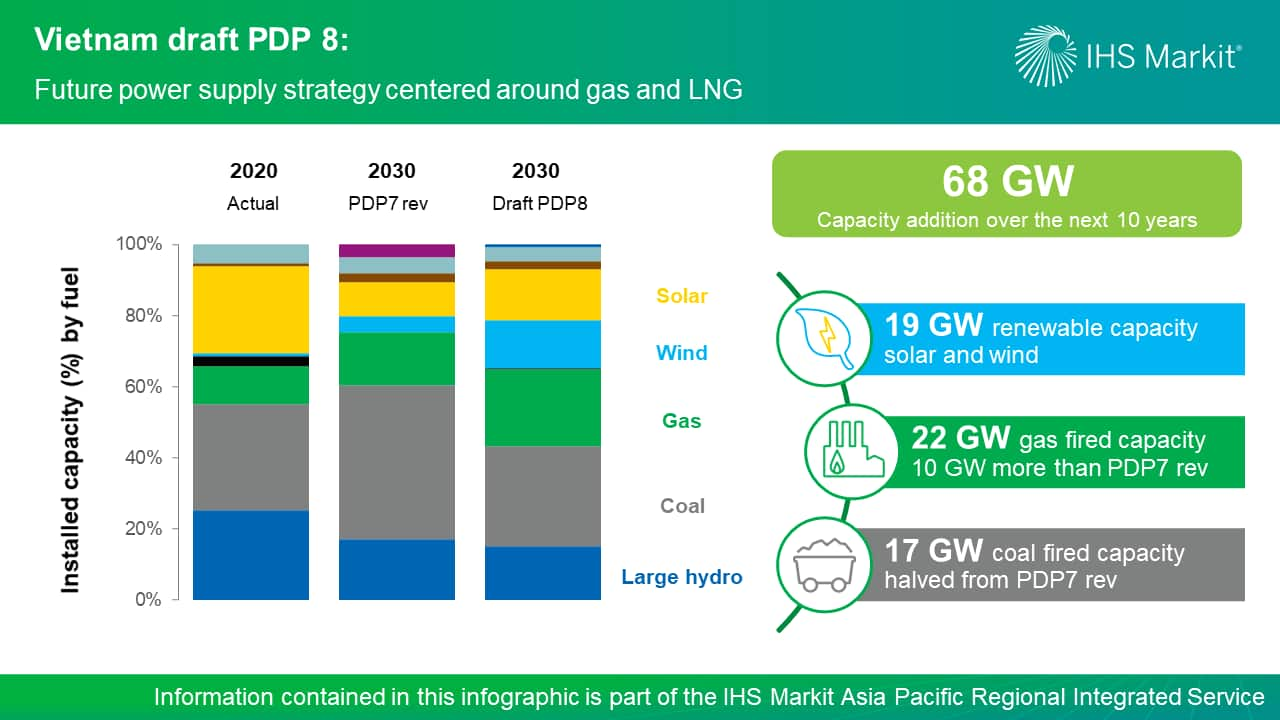Customer Logins
Obtain the data you need to make the most informed decisions by accessing our extensive portfolio of information, analytics, and expertise. Sign in to the product or service center of your choice.
Customer Logins
BLOG
Apr 22, 2021
Draft PDP8 outlines Vietnam’s future power supply strategy centered around gas and LNG
On 22 February 2021, Vietnam's Ministry of Industry and Trade (MOIT) released the third revision of the draft power development plan (draft PDP8) for 2021‒30, with a vision to 2045. The implications of the draft PDP8 are summarized here.
Draft PDP8 forecasts lower power demand. This is a combined effect of COVID-19 driving down power demand in 2020 and slower economic growth through 2030. Peak demand is estimated to be 4.6‒7.2% lower than in PDP7 rev[1] over the next 10 years and total power supply to be 5.8‒11.4% lower. However, despite the slowdown, the demand forecast overall still is optimistic and likely will be suppressed by the potential power source project delay.
Draft PDP8 envisions gas-fired power as the backbone of the power system. Thermal capacity addition remains significant in the plan, with 39 GW of thermal capacity (17 GW coal and 22 GW gas/LNG) projected to come online in the next decade, as opposed to an additional 19 GW of solar and wind capacity in the same period. The plan clearly prioritizes gas power projects to replace coal, and substantial renewable expansion during 2018-20 was not likely considered. Besides, 84% of thermal addition will be from imported fuel, raising concerns about energy security.

Draft PDP8 continues to develop a transmission grid of 500 kV and 220 kV to improve regional interconnectivity and to set a flexible and reliable network to support renewable integration. It plans to have 90% of the transmission grid meet N-1 criteria[2] from 2025 and 100% from 2030. Furthermore, it prioritizes an upgrade of the main power grids and grids that are connected to thermal power sources, aiming for 100% of these grids to meet N-1 criteria from 2025. Meanwhile, grids connecting renewables are required to meet only N-0 criteria. The MOIT estimates an annual $3.3 billion will be required for power grid construction, and this is challenging without an established mechanism to attract private investments to the sector.
All in all, the draft PDP8 shows the ambition of Vietnam to accelerate the energy transition and to make the power sector greener. The PDP8 likely will be the main guideline for the power sector in the next 5‒10 years. However, it has also illustrated development constraints, such as fuel supply, infrastructure development, power supply reliability, lack of investment support, and the need for market reform. It paves the way for Vietnam's power sector for the next 25 years but does not fully address the key concerns or provide a practical approach to achieve the long-term targets.
The final version of PDP8 will be issued soon. IHS Markit will continue to monitor the progress and issue updates when available.
To learn more about Asia Pacific energy research, visit our Asia Pacific Regional Integrated Service page.
Cecillia Zheng is an associate director with the Climate and Sustainability team at IHS Markit.
Posted 22 April 2021
[1] N-1 criterion is an acceptable reliability level that the power system is able to withstand at all times an unexpected failure or outage of one single system component
[2] PDP7 rev stands for the revision of the seventh power development plan, released in 2016
This article was published by S&P Global Commodity Insights and not by S&P Global Ratings, which is a separately managed division of S&P Global.
{"items" : [
{"name":"share","enabled":true,"desc":"<strong>Share</strong>","mobdesc":"Share","options":[ {"name":"facebook","url":"https://www.facebook.com/sharer.php?u=http%3a%2f%2fwww.spglobal.com%2fcommodityinsights%2fen%2fci%2fresearch-analysis%2fdraft-pdp8-outlines-vietnams-future-power-supply-strategy-cent.html","enabled":true},{"name":"twitter","url":"https://twitter.com/intent/tweet?url=http%3a%2f%2fwww.spglobal.com%2fcommodityinsights%2fen%2fci%2fresearch-analysis%2fdraft-pdp8-outlines-vietnams-future-power-supply-strategy-cent.html&text=Draft+PDP8+outlines+Vietnam%e2%80%99s+future+power+supply+strategy+centered+around+gas+and+LNG++%7c+S%26P+Global+","enabled":true},{"name":"linkedin","url":"https://www.linkedin.com/sharing/share-offsite/?url=http%3a%2f%2fwww.spglobal.com%2fcommodityinsights%2fen%2fci%2fresearch-analysis%2fdraft-pdp8-outlines-vietnams-future-power-supply-strategy-cent.html","enabled":true},{"name":"email","url":"?subject=Draft PDP8 outlines Vietnam’s future power supply strategy centered around gas and LNG | S&P Global &body=http%3a%2f%2fwww.spglobal.com%2fcommodityinsights%2fen%2fci%2fresearch-analysis%2fdraft-pdp8-outlines-vietnams-future-power-supply-strategy-cent.html","enabled":true},{"name":"whatsapp","url":"https://api.whatsapp.com/send?text=Draft+PDP8+outlines+Vietnam%e2%80%99s+future+power+supply+strategy+centered+around+gas+and+LNG++%7c+S%26P+Global+ http%3a%2f%2fwww.spglobal.com%2fcommodityinsights%2fen%2fci%2fresearch-analysis%2fdraft-pdp8-outlines-vietnams-future-power-supply-strategy-cent.html","enabled":true}]}, {"name":"rtt","enabled":true,"mobdesc":"Top"}
]}

